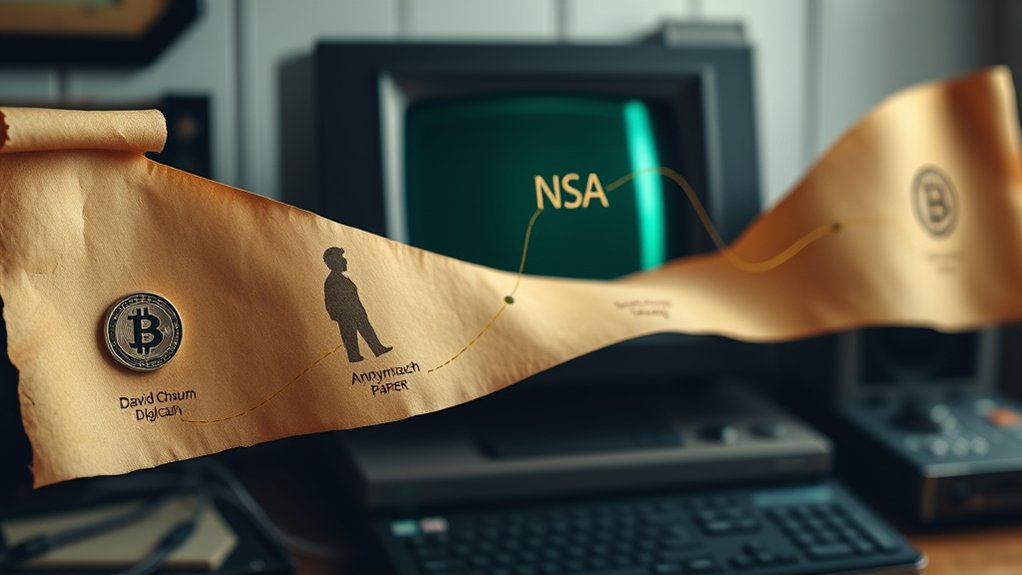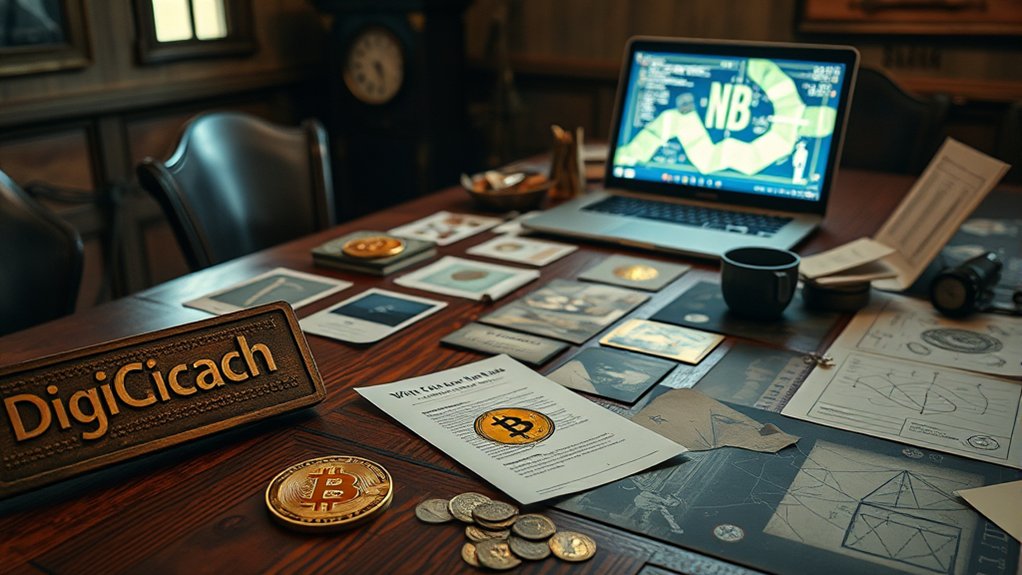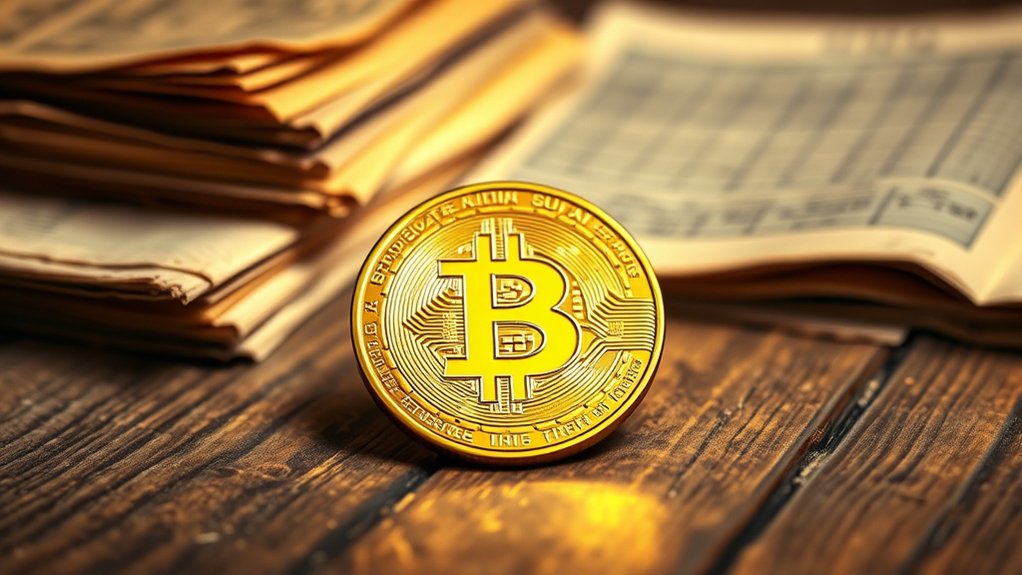The origins of cryptocurrency start in the early 1980s with digital money ideas that were ahead of their time. Fast forward to 2009, Bitcoin hit the scene and went all-in on decentralization. Since then, a chaotic mix of coins like Litecoin and Peercoin joined the party. It hasn’t been smooth sailing—volatility and security concerns are a given. But hey, it’s a rollercoaster that keeps grabbing headlines. Curious about the wild ride? There’s more to discover.

When David Chaum first dreamed up cryptographic electronic money back in 1983, he probably didn’t realize he was planting the seeds for a financial revolution. In the late 1980s, he released DigiCash, a system that allowed for anonymous digital payments. Sounds revolutionary, right? Unfortunately, it faced a mountain of regulatory challenges, which kept it from becoming the next big thing. By 1998, it filed for bankruptcy. Surprise, surprise.
Fast forward to 1996 when the NSA thought it could get in on the action by publishing a paper on “Anonymous Electronic Cash.” Then came the late ’90s with wild ideas like B-Money and Bit Gold, proposing decentralized digital currencies. These were the brainchildren of tech enthusiasts who dreamed of a world free from banking overlords.
In the late ’90s, tech visionaries imagined a decentralized utopia with concepts like B-Money and Bit Gold, challenging traditional banking.
Enter Hashcash in 1997, a proof-of-work scheme that was initially meant to stop spam but would later play a pivotal role in cryptocurrency. Hal Finney took that idea and ran with it, contributing to reusable proof-of-work. It was like a game of tech tag.
Then, in October 2008, the magic happened. Bitcoin’s whitepaper dropped, and a domain was registered. By January 3, 2009, the Bitcoin network launched with a bang—the genesis block was mined. The world met the first fully functional decentralized blockchain, and it was a game-changer. Early supporters like Hal Finney and Nick Szabo were probably high-fiving each other. Cryptocurrency ownership records are maintained in a blockchain, secured by cryptography, with individual coin ownership verifiable through cryptographic proofs. The first Bitcoin transaction occurred in 2009 among tech enthusiasts, marking the beginning of its journey into the mainstream, which ultimately led to the emergence of Bitcoin Pizza Day as a cultural milestone.
After Bitcoin’s debut, the floodgates opened. Litecoin, Namecoin, and Peercoin appeared like popcorn in a microwave, each trying to carve out its niche in the crypto landscape. But it wasn’t all smooth sailing. Market volatility, security issues, and regulatory scrutiny were constant companions.
Still, businesses started embracing cryptocurrencies, giving them a shot. And just like that, a new financial ecosystem began to take root, full of promise and chaos. Welcome to the wild world of cryptocurrency.
Frequently Asked Questions
What Are the Different Types of Cryptocurrencies Available Today?
Today’s cryptocurrency landscape is like a chaotic carnival.
You’ve got Bitcoin, the granddaddy of them all, then Litecoin, speedier but still a cousin.
Ethereum plays with smart contracts, while Ripple focuses on banks.
Let’s not forget Dogecoin—originally a joke, now a community favorite.
Meanwhile, stablecoins like Tether keep things from going totally haywire.
It’s a wild mix, and everyone’s trying to figure out what’s worth their time—and money.
Good luck!
How Do Cryptocurrencies Differ From Traditional Currencies?
Cryptocurrencies and traditional currencies? Totally different beasts.
Cryptos are decentralized, running wild on blockchain tech, while traditional cash is tamed by banks and governments. Want fixed supply? Hello, Bitcoin! But good luck keeping that value stable; cryptos are like a rollercoaster.
Plus, they promise privacy—sort of. Transactions are public, but your name? Nah.
Acceptance? Still a work in progress.
What Is the Role of Blockchain Technology in Cryptocurrency?
Blockchain technology is the backbone of cryptocurrency.
It’s like the rulebook for a game, but way cooler and way more secure. Transactions? They’re recorded on this decentralized ledger, making tampering nearly impossible. No middlemen, just pure, unfiltered peer-to-peer action.
And let’s not forget about smart contracts—automated agreements that save everyone from paperwork headaches.
It’s a wild world, and blockchain is the gatekeeper, changing finance forever. Who knew tech could be this revolutionary?
How Can I Safely Store My Cryptocurrency?
To safely store cryptocurrency, one must choose wisely.
Hardware wallets? Yes, they’re the gold standard—keeping those pesky private keys offline.
Software wallets? Risky business.
Got a paper wallet? Just pray you don’t lose it.
Diversify your storage like it’s a buffet; don’t put all your eggs in one basket.
And for heaven’s sake, back things up! A lost key means lost coins.
What Are the Environmental Impacts of Cryptocurrency Mining?
Cryptocurrency mining is a real environmental mess.
Think carbon emissions—Bitcoin alone pumped out 86 megatons in 2023. That’s like a small country’s worth!
The U.S. is the biggest culprit, but Kazakhstan and China are no saints either.
And let’s not forget the energy drain; it guzzles more power than Poland.
Sure, some renewable sources are used, but mostly it’s fossil fuels.





